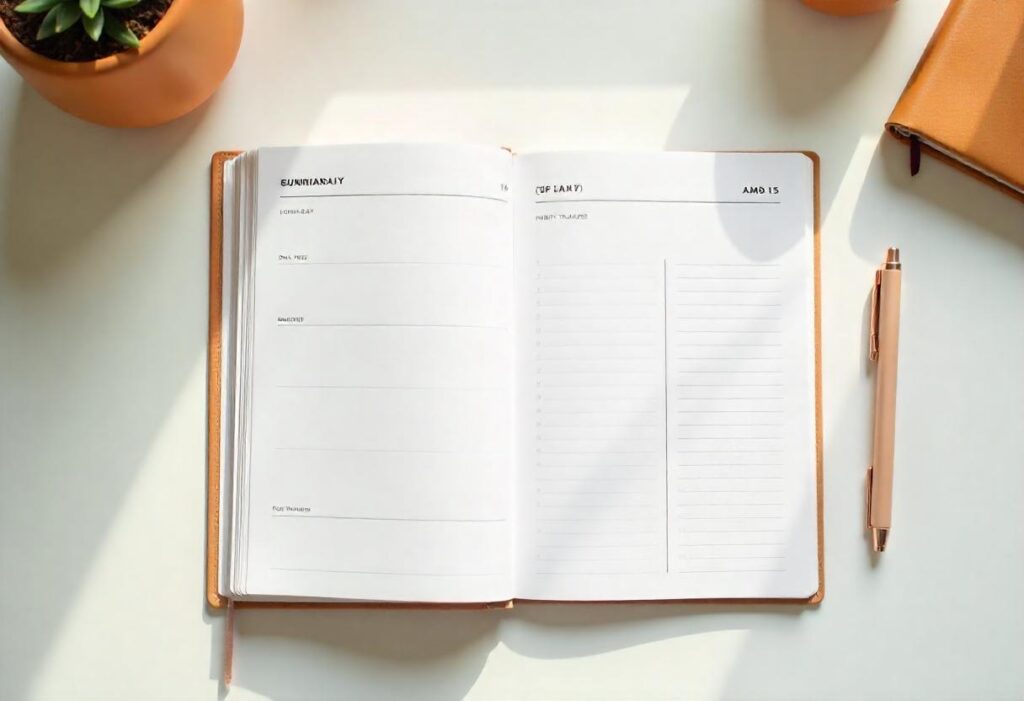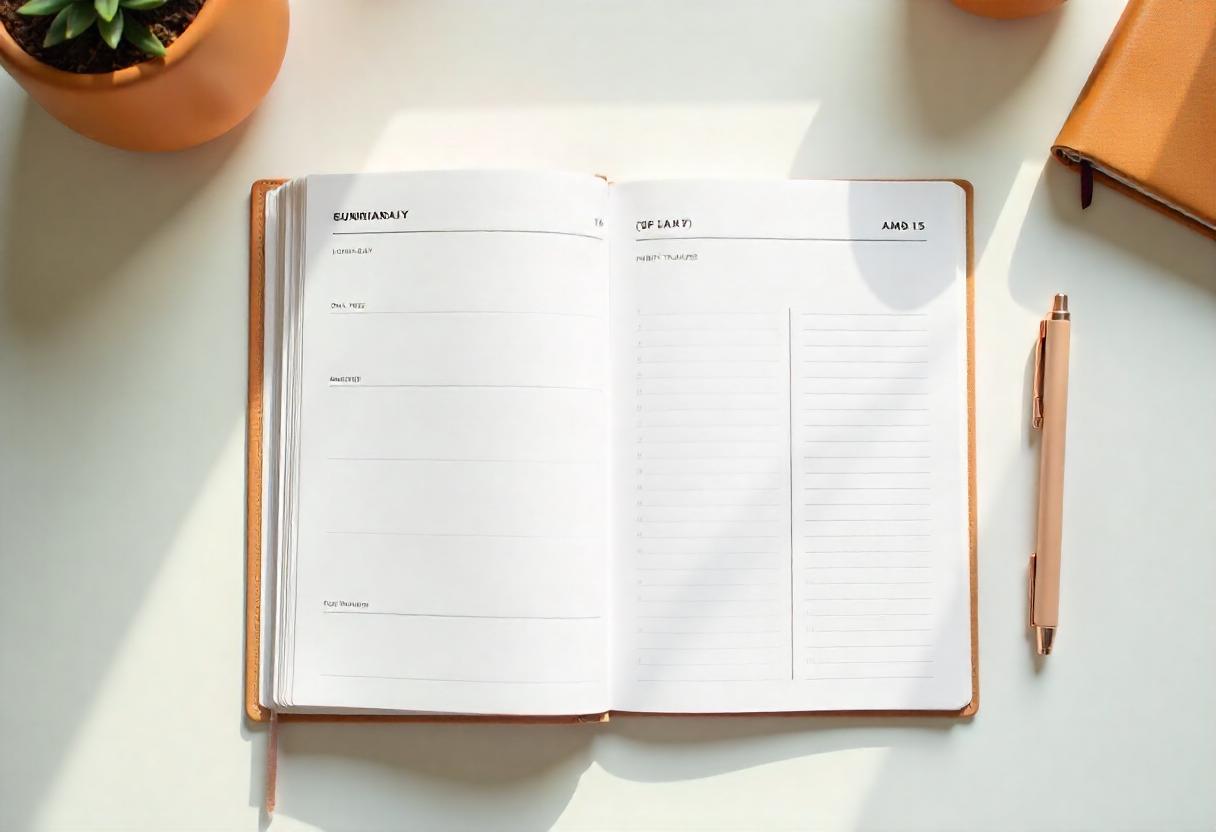Feeling overwhelmed by daily tasks? A weekly planner template can help. It turns chaos into control. These tools act as your personal roadmap, helping you manage time better and boost productivity.
Whether you’re balancing work, family, or personal goals, the right template keeps you focused. It helps you stay on track.
Weekly planning with a customizable template streamlines goals and reduces stress. Productivity tools like these help you see your schedule at a glance. This ensures nothing slips through the cracks.
Stay organized with a system tailored to your lifestyle. This is different from generic lists that don’t fit your rhythm.
Key Takeaways
- A weekly planner template is a core productivity tool for time management.
- Custom templates adapt to your work style—digital or printable options available.
- Weekly planning reduces overwhelm by visualizing priorities and deadlines.
- Staying organized with a template improves focus and reduces procrastination.
- Choose a system that balances work, rest, and personal goals for better results.

Why Using a Weekly Planner Template Transforms Your Productivity
Weekly planner templates do more than list tasks. They are tools for productivity transformation. They help you plan your week ahead, leading to clearer focus. This simple habit can change your daily life.
Reducing Mental Load Through Structured Planning
Your brain acts like a never-ending to-do list. This is mental load reduction in action. Writing down tasks frees up your mind for creativity and solving problems.
Psychologists say the Zeigarnik effect makes unfinished tasks stay in our minds. A planner helps by putting these tasks outside of our heads, reducing stress.
“Writing tasks down reduces cognitive load by 40%,” says Dr. Laura Vanderkam, time management expert.
Balancing Work and Personal Commitments
A good template helps you balance work and personal life. Here are some tips:
- Mark out “personal time” like family time
- Set work hours and stick to them
- Use colors to show what’s important for work or family
Creating Visual Accountability for Your Goals
Visual planning makes vague goals clear. Here’s how different methods compare:
| Traditional Methods | Visual Planning |
| Written lists | Color-coded calendars |
| Unclear priorities | Goal tracking with progress bars |
| Missed deadlines | Weekly reviews to adjust timelines |
Seeing your week in a visual way makes goal tracking easy. Studies show 70% of users with visual systems reach their goals faster.
Types of Weekly Planner Templates for Different Needs
Weekly planners come in many styles to fit your lifestyle. You can choose from digital or paper, simple or detailed. Let’s look at the options to find what suits you best.
Digital vs. Printable Weekly Planners
Digital planners like Notion or Google Calendar update in real-time and are cloud-based. On the other hand, printable weekly planners let you write and highlight by hand. Choose based on whether you prefer tech or paper.
Minimalist Weekly Planning Templates
Minimalist planners focus on simplicity, with clean layouts. Brands like Passion Planner or free templates online help you stay focused. They’re perfect for those who like a clean, simple approach.
Goal-Oriented Weekly Planners
Goal planners help you connect daily tasks to big goals. Use SMART goals to track your progress. For example, you might plan weekly workouts and to-do lists.
Time-Blocked Weekly Templates
Time blocking templates schedule specific times for tasks. Experts say this helps avoid doing too many things at once. Laura Vanderkam once said:
“Time blocking turns chaos into clarity by dedicating blocks to work and rest.”
How to Effectively Use Your Weekly Planner for Maximum Results
Building strong planner habits starts with a consistent weekly planning routine. Choose a set time, like Sunday evenings or Friday afternoons, to review the week and plan for the next. This planner setup helps you tackle tasks clearly.
- Begin each week with a 10-minute review: note what’s done, adjust deadlines, and jot down new goals.
- Use the Eisenhower Matrix to sort tasks by urgency/importance. Tackle high-impact items first (“eat the frog” style).
Don’t overcommit by leaving time for surprises. Track time spent on tasks to improve effective planning. For example, teachers use 30-minute blocks for lesson prep and grading without burnout.
- Pitfall 1: Filling every slot. Leave 1-2 open slots daily.
- Pitfall 2: Ignoring past patterns. Use your planner’s notes to refine next week’s plan.
Flexibility is key. If Monday’s goals shift, adjust your planning strategies without guilt. Remember: consistency matters more than perfection.
“The goal isn’t to follow the plan, but to plan to follow.” – Naval Ravikant
Mastering planner setup takes practice. Try these steps for two weeks, then tweak based on what works best for your rhythm.
Customizing Your Weekly Planner Template to Fit Your Lifestyle
Make your weekly planner your own with simple steps. Whether you like digital or paper, small changes can make a big difference. These tweaks turn generic templates into tools that really work for you.
Color-Coding Systems That Make Planning Intuitive
Use a color-coding system to add clarity. Try these color combinations:
- Blue = professional tasks
- Green = wellness planning
- Orange = personal time
Digital apps like Notion or Excel let you change colors easily. Physical planners use highlighters for the same effect.
Adding Habit Trackers and Wellness Sections
Make your planner a wellness buddy with these features:
| Habit | Tracking Method | Goal |
| Hydration | Checkmark grid | 8 glasses/day |
| Meditation | Time log | 10-min sessions |
Include space for journaling or mood tracking. This boosts mental health awareness.
Adapting Your Template for Seasonal Changes
Update your planner for life’s changes. For back-to-school, add seasonal planning sections for lists or schedule changes. Holiday periods might need event countdowns or gift trackers. Tax season could have slots for document reviews. Adjust margins or add sticky notes for quick updates.
Conclusion: Transform Your Days With Consistent Weekly Planning
Building planning consistency makes every day a chance for productivity improvement. A weekly planner is more than a tool; it’s a habit. Spend just 10 minutes each week planning your goals. This helps reduce stress and boosts time management success.
Whether you like simple layouts or detailed grids, there’s a template for you. It fits your pace.
Studies reveal that those who plan weekly cut stress by 40% and finish tasks 30% faster. Think of a teacher who organized lessons with a digital template or a freelancer balancing work and family with habit trackers. These stories show how planning brings clarity and focus.
Begin with a small change. Add a new section to your schedule, like a wellness area or a project tracker. As life changes, adjust your templates. But the core of consistent planning remains the same.
Every task you mark and every break you schedule brings you closer to a more intentional life. Your journey starts with a simple choice: open your planner and plan tomorrow’s tasks. Small steps today lead to big wins. Choose a system that works for you and see how order brings calm. The journey to better time management begins today. What’s your first step?
FAQ
What is a weekly planner template?
A weekly planner template is a tool to organize your tasks and goals for the week. It can be digital or printable. It has sections for scheduling, priorities, and notes to boost productivity and time management.
How can I choose the right weekly planner template for my needs?
To pick the right template, think about your style and preferences. Do you like digital or printable? Also, consider how busy your week is. Look for features that fit your planning style, like color-coding or space for notes.
Can I customize my weekly planner template?
Yes, you can definitely customize your template! Add color-coding, habit trackers, and adjust sections to match your lifestyle. Making it your own makes it more effective for you.
What’s the best time to plan my week?
The best times to plan are usually Sunday evenings or Friday afternoons. These quiet times let you reflect on the week and plan for the next one.
How do I avoid overcommitting in my weekly planner?
To avoid overcommitting, prioritize tasks by importance and urgency. Use tools like the Eisenhower Matrix or “eat the frog” to tackle key tasks first. This helps you stay focused and not overextend yourself.
Is it possible to use a weekly planner for personal as well as work commitments?
Yes, it’s possible! A good weekly planner can handle both personal and work tasks. By separating sections and setting aside time for each, you can balance work and life well.

